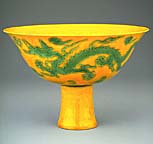
presents
The Splendors of Imperial China:
Treasures from the National
Palace Museum, Taipei

presents
The Splendors of Imperial China:
Treasures from the National
Palace Museum, Taipei
 |
 |
 |
| 8. Stem cup with dragon motif | 9. Three leaves from Landscapes and Flowers | 10. Celestial globe vase |
|
Visitors to the San Francisco presentation of Splendors will have the opportunity to view numerous works that have never been seen outside of China. Two life-size imperial portraits -- Portrait of Sung Jen-tsung (anonymous, 11th century) and Portrait of the Hungwu emperor (anonymous, 14th century), are among those showcased. The exhibition features a selection of the finest known examples of imperial ceramics from the Sung through Ch'ing periods, as well as stunning cloisonne, enamels, snuff bottles, and writing tools. Rare treasures in jade are complemented by an array of lacquerwares including boxes, trays, vases and screens. Of particular note are the exquisite treasure boxes of the Ch'ien-lung emperor that replicate in miniature his personal favorites from the imperial collection.
"In the future, when the Asian's permanent collection is reinstalled, those who have seen this remarkable exhibition will have many more opportunities to enjoy and appreciate spectacular Chinese art," said Asian Art Museum Curator of Chinese Art Dr. Michael Knight. "Fortunately for all of us in San Francisco, our founder Avery Brundage also had a magnificent eye." Splendors of Imperial China opened to critical acclaim at The Metropolitan Museum of Art in New York (March l9-May 19, 1996), and went on to impressive crowds at the Art Institute of Chicago (June 29-August 25, 1996). After showing in San Francisco, the exhibition will conclude its historic U.S. tour at the National Gallery of Art in Washington, D.C. (January 27-April 6, 1997).
Two catalogues have been produced for this exhibition: Possessing the Past: Treasures from the National Palace Museum, Taipei, by Wen C. Fong and James C.Y. Watt, is 664 pages with 600 illustrations; the full-color clothbound edition is available for 85.00. Splendors of Imperial China: Treasures from the National Palace Museum, Taipei. by Maxwell K. Hearn, is 144 pages with 119 illustrations and costs $30.00. In addition, an electronic catalogue on CD ROM is available for $30.00. All items may be purchased in advance through the Exhibition Kiosk at the Asian Art Museum: 415/379-8806/379-8807.
This exhibition been organized by the National Palace Museum, Taipei, and The Metropolitan Museum of Art, New York. It is supported in part by The Henry Luce Foundation, The Starr Foundation, the National Endowment for the Humanities, the National Endowment for the Arts, and an indemnity from the Federal Council on the Arts and the Humanities. Transportation assistance has been provided by China Airlines. Support for local presentation has been generously provided in part by The Chase Manhattan Private Bank, the Bernard Osher Foundation, KGO-Newstalk AM 810, KGOTV Channel 7, The San Francisco Chronicle, and Grants for the Arts of the San Francisco Hotel Tax Fund. |
all text and images © National Palace Museum, Taipei